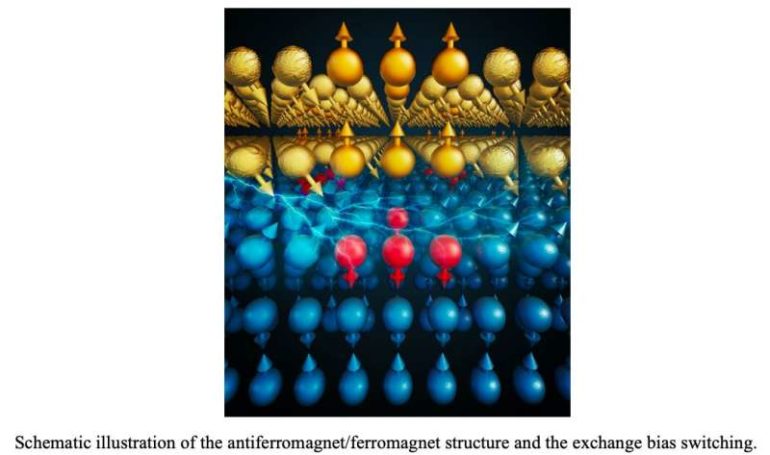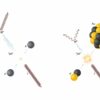The identification of effective methods to manipulate both magnetization and exchange bias in thin antiferromagnet/ferromagnet films could facilitate the development of new types of spintronic devices. Magnetization switching could be achieved by inducing a phenomenon called spin-orbit torque (SOT) in a heavy metal layer adjacent to these films. However, so far, this design strategy has proved difficult to combine with both exchange bias switching and tunneling magnetoresistance measurements.
Researchers at Beihang University in China, University of California- Los Angeles (UCLA) and other institutes in the U.S. have recently demonstrated current-induced exchange bias switching in an antiferromagnet/ferromagnet (IrMn/CoFeB) bilayer structure. They achieved this by generating a SOT in the structure’s antiferromagnetic layer.
The researchers started investigating the potential of antiferromagnet/ferromagnet/oxide structures a few years ago. In a study published last year, they were able to achieve the field-free switching of a IrMn/CoFeb/MgO structure’s perpendicular magnetization by generating a voltage-gated SOT with the aid of an an exchange bias field. Subsequently, drawing inspiration from a recent paper that reported the manipulation of exchange bias via the generation of SOT, they started to explore exchange bias switching in the same IrMn/CoFeb/MgO structure.
“We were interested in this topic because the exchange bias field is usually considered to be quite robust, difficult to be reversed unless the ambient temperature is higher than the blocking or even Neel temperature of the antiferromagnetic layer,” Weisheng Zhao, one of the researchers who carried out the study, told TechXplore. “On the other hand, we intended to verify if the exchange bias field can be switched by SOT in antiferromagnet (AFM)/ferromagnet (FM)/oxide stacks because it is easier, compared than in AFM/FM/heavy-metal structures, to integrate tunneling magnetoresistance (for electrical reading of FM magnetization), SOT and exchange bias switching in a single device.”
In their recent study, Zhao and his colleagues set out to study the manipulation of both exchange bias and magnetization in IrMn/CoFeB/MgO structures, where the SOT originates from the antiferromagnetic layer IrMn. Their findings demonstrate the feasibility of switching the exchange bias field in this structure by generating a SOT.
“Independent manipulation of ferromagnetic magnetization and exchange bias field can be realized by controlling the direction and magnitude of SOT currents,” Zhao said. “We also found that the critical current density for the exchange bias switching is larger than that for CoFeB magnetization reversal. We further elucidated this mechanism with X-ray magnetic circular dichroism (XMCD), polarized neutron reflectometry (PNR) measurements and micromagnetic simulations, which show that a small net magnetization within the IrMn interface plays a crucial role in these phenomena.“
In the structure examined by the researchers, exchange bias manifests as a shift in the hysteresis loop of the ferromagnetic layer. This means that it can be experimentally obtained by sweeping the perpendicular magnetic field (Hz) and then extracting the loop shift.
As Zhao and his colleagues were specifically examining the possibility of eliciting exchange bias switching via SOT generation, they measured the hysteresis loop of the FM layer before and after they applied a SOT pulse. By comparing the corresponding loop shift, they were able to determine that the exchange bias had actually switched.
“When it comes to the mechanism of the SOT-driven exchange bias switching, in our experiments, we found that the switching of exchange bias by SOT is somewhat similar to that of perpendicular FM magnetization,” Zhao said. “More specifically, to switch the exchange bias or perpendicular FM magnetization, we need to apply SOT in the presence of an in-plane field and the switching polarity depends on the SOT current polarity.”
Using XMCD and PNR techniques, as well as micromagnetic simulations, the researchers showed that a small net magnetization within the IrMn interface plays a crucial role in enabling the phenomena they observed. Therefore, it is reasonable to depict a physical picture that the switching of exchange bias originates from the switching of interfacial pinned spins, which exhibit a behavior that resembles that associated with the perpendicular magnetization of the ferromagnetic layer.
“While our results are exciting, it is still necessary to consider the influence of the property of the bulk AFM,” Zhao said. “For example, we still need to verify whether the bulk AFM magnetization is also reversed when switching the exchange bias, which could help us understand deeper the physics of AFM and exchange bias. This may need direct detection of the AFM moments but is also, without a doubt, a hard nut to crack.”
The researchers’ findings opened up new possibilities for the electrical manipulation of exchange bias in AFM/ FM/oxide stacks, which could ultimately have important implications for the development of spintronic devices, especially seeing as these particular structures have the potential to integrate tunneling magnetoresistance, SOT and exchange bias switching. In addition, their paper sheds light on the mechanism underlying exchange bias switching in IrMn/CoFeB/MgO structures.
“The independent manipulation of FM magnetization and exchange bias field, as demonstrated in our work, could stimulate novel functionalities for spintronic devices,” Zhao said. “That is what we plan to explore. Besides, the impact of the bulk property of AFM on the exchange bias switching has not been identified in our study. Therefore, we also plan to further study the mechanism of SOT-driven exchange bias switching.”
Exchange bias in van der Waals heterostructures
More information:
Exchange bias switching in an antiferromagnet/ferromagnet bilayer driven by spin-orbit torque. Nature Electronics(2020). DOI: 10.1038/s41928-020-00504-6.
2021 Science X Network
Citation:
The demonstration of exchange bias switching in antiferromagnet/ferromagnet structure (2021, January 11)
retrieved 11 January 2021
from https://techxplore.com/news/2021-01-exchange-bias-antiferromagnetferromagnet.html
This document is subject to copyright. Apart from any fair dealing for the purpose of private study or research, no
part may be reproduced without the written permission. The content is provided for information purposes only.



